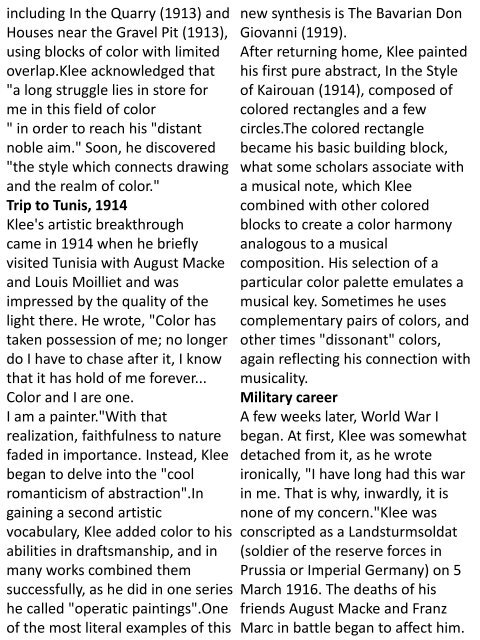Aziz Art July 2019
History of art(west and middle east)- contemporary art ,art ,contemporary art ,art-history of art ,iranian art ,iranian contemporary art ,middle east art ,european art
History of art(west and middle east)- contemporary art ,art ,contemporary art ,art-history of art ,iranian art ,iranian contemporary art ,middle east art ,european art
Create successful ePaper yourself
Turn your PDF publications into a flip-book with our unique Google optimized e-Paper software.
including In the Quarry (1913) and<br />
Houses near the Gravel Pit (1913),<br />
using blocks of color with limited<br />
overlap.Klee acknowledged that<br />
"a long struggle lies in store for<br />
me in this field of color<br />
" in order to reach his "distant<br />
noble aim." Soon, he discovered<br />
"the style which connects drawing<br />
and the realm of color."<br />
Trip to Tunis, 1914<br />
Klee's artistic breakthrough<br />
came in 1914 when he briefly<br />
visited Tunisia with August Macke<br />
and Louis Moilliet and was<br />
impressed by the quality of the<br />
light there. He wrote, "Color has<br />
taken possession of me; no longer<br />
do I have to chase after it, I know<br />
that it has hold of me forever...<br />
Color and I are one.<br />
I am a painter."With that<br />
realization, faithfulness to nature<br />
faded in importance. Instead, Klee<br />
began to delve into the "cool<br />
romanticism of abstraction".In<br />
gaining a second artistic<br />
vocabulary, Klee added color to his<br />
abilities in draftsmanship, and in<br />
many works combined them<br />
successfully, as he did in one series<br />
he called "operatic paintings".One<br />
of the most literal examples of this<br />
new synthesis is The Bavarian Don<br />
Giovanni (1919).<br />
After returning home, Klee painted<br />
his first pure abstract, In the Style<br />
of Kairouan (1914), composed of<br />
colored rectangles and a few<br />
circles.The colored rectangle<br />
became his basic building block,<br />
what some scholars associate with<br />
a musical note, which Klee<br />
combined with other colored<br />
blocks to create a color harmony<br />
analogous to a musical<br />
composition. His selection of a<br />
particular color palette emulates a<br />
musical key. Sometimes he uses<br />
complementary pairs of colors, and<br />
other times "dissonant" colors,<br />
again reflecting his connection with<br />
musicality.<br />
Military career<br />
A few weeks later, World War I<br />
began. At first, Klee was somewhat<br />
detached from it, as he wrote<br />
ironically, "I have long had this war<br />
in me. That is why, inwardly, it is<br />
none of my concern."Klee was<br />
conscripted as a Landsturmsoldat<br />
(soldier of the reserve forces in<br />
Prussia or Imperial Germany) on 5<br />
March 1916. The deaths of his<br />
friends August Macke and Franz<br />
Marc in battle began to affect him.

















